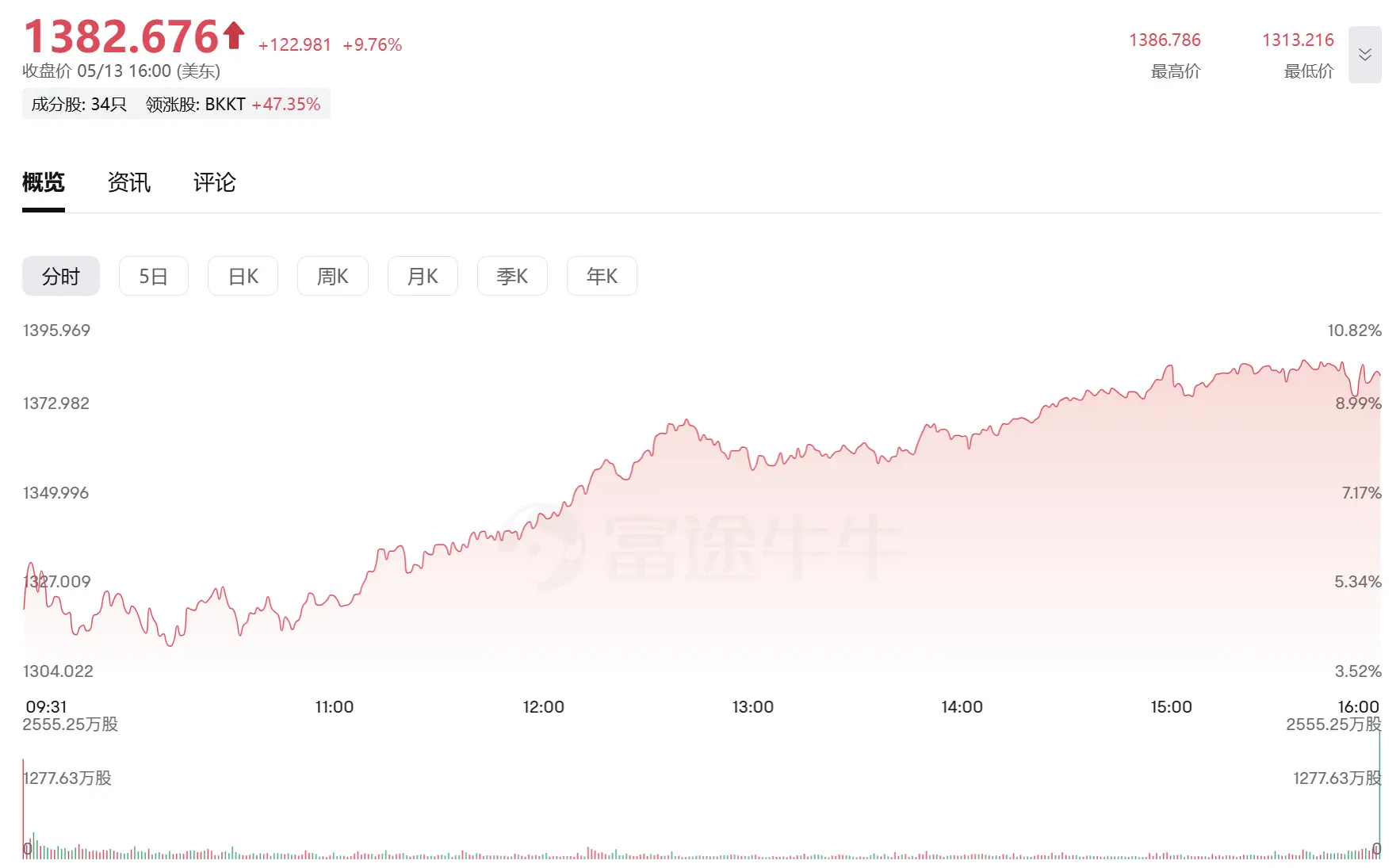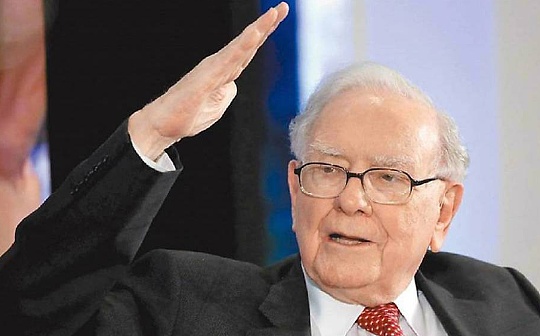Bakkt leads the rise, and crypto stocks start "second entrepreneurship"?

Reprinted from panewslab
05/15/2025·25DAuthor: Scof, ChainCatcher
Edited by: TB, ChainCatcher
Without warm-up and no major positive news, the crypto concept stock Bakkt soared by more than 50% overnight.
Not long ago, Bakkt was marginalized by the market due to customer churn and revenue decline, but now it has suddenly become the hot search and has become the most eye-catching existence among crypto stocks. What rhythm has you hit behind the seemingly accidental surge? Is it a short-term speculative game, or a signal that the industry trend is quietly turning?
Bakkt is soaring, is it an opportunity or emotion?
On May 13, Bakkt's stock price soared by more than 50% in a short period of time. The company, once regarded as the "bridge of traditional finance entering the crypto world", has been in the dilemma of customer churn and revenue shrinking in the past few years. This sudden reversal has attracted market attention. The surface reason is that it achieved a net profit of US$7.7 million in the first quarter, which is the first profit in recent years. But if you look closely at the financial report, you will find that this is mainly due to cost reductions and one-time adjustments, and the core business has not improved significantly.
What really ignites the mood is the new strategy released by the company. Bakkt announced a partnership with DTR, founded by former SoftBank executives, to launch AI plug-ins and stablecoin payment services, entering the popular "PayFi" track - that is, a global payment infrastructure combining AI agents and on-chain settlement. This "new narrative" that superimposes AI and encryption has quickly stimulated market hype.
In addition, Bakkt's "M&A concept" has also been reactivated. Although the previous acquisition negotiations with Trump's TMTG were unsuccessful, ICE still holds more than half of its shares, and the market also reported that Apex Fintech may take over. Driven by the extremely small circulation market and the proportion of short sellers as high as 23%, the short squeeze market has quickly staged and the stock price has been quickly pulled up.

From a fundamental perspective, the platform is still under tremendous pressure. On the one hand, Bakkt's major client Nasdaq listed broker Webull will terminate its cooperation with him in June. Bakkt once provided cryptocurrency trading and custody services to Webull, and the revenue generated by this part of the services once accounted for more than 70% of Bakkt's total revenue. On the other hand, Bank of America will also end its cooperation with Bakkt. The termination of this cooperation will affect Bakkt's loyalty service sector, which mainly provides corporate customers with solutions such as points redemption and digital rewards.
With the loss of two major customers, Bakkt's revenue structure has become more vulnerable. This round of surge is more like a concentrated release of short-term sentiment in the market, rather than a substantial turning point in fundamentals.
Crypto stocks are collectively restless, what is the market betting on?
Bakkt's abnormal movement is not an isolated phenomenon. During the same period of time, the crypto concept stock sector generally strengthened, and multiple stocks rose significantly. Coinbase rose 23.97%, TeraWulf rose 10.06%, Amber Group and DMG Blockchain rose nearly 10%, and MicroStrategy also rebounded by more than 4%. Overall, the weekly increase of the crypto stock sector is close to 10%, showing the intensive layout of funds in the track.

However, more importantly, the market is beginning to re-examine the value of encryption "infrastructure". In the past few cycles of the crypto market, most of the funds flowed to exchanges, platform coins or mining companies, but now investors' attention has gradually turned to those "pipeline-style" companies
- companies that provide custody, settlement, clearing, compliance, risk control and other services. They are more like this ecological water, electricity and coal, with a stable income model and are easier to adapt to the valuation system of traditional finance. Bakkt's surge is hitting this structural preference, and it is not the only one.
Traditional finance is entering the market in full
The real turning point in the crypto industry is not the short-term rise in the stock price of a certain platform, but the fact that more and more traditional financial institutions are choosing to join this game.
Internet brokers in Hong Kong have taken the lead in taking action. Futu Securities has launched a cryptocurrency trading service, allowing users to directly recharge and trade mainstream currencies such as Bitcoin, Ethereum, and USDT through Hong Kong and US stock accounts; Tiger Securities has launched the functions of depositing, trading and withdrawing crypto assets, and connected them with traditional stock trading; Victory Securities has also been licensed to support crypto asset-related businesses and is at the forefront of the market. Standard Chartered Bank's Hong Kong subsidiary announced that it would participate in the Hong Kong Monetary Authority's stablecoin sandbox with its partners, trying to explore on-chain payment solutions under the compliance framework.
At the same time, the global payment giants are more radical. Stripe launches stablecoin accounts and programmable stablecoin USDB, providing services in 101 countries; Visa and Mastercard have expanded their integration with partners such as Circle, connecting stablecoins such as USDC to their payment network, and users can complete on-chain asset consumption through traditional cards; PayPal uses a 3.7% yield to attract users to hold PYUSD, trying to build a closed loop of settlement based on stablecoins. Even old cross-border remittance companies like MoneyGram connect traditional cash and on-chain assets through stablecoin "Ramps", covering more than 170 countries.
The common direction of these trends is that traditional finance no longer regards encryption as a disaster, but begins to actively "chain" itself. This not only responds to changes in user needs, but also pursues cost efficiency. Stablecoins and blockchain technologies provide a faster, cheaper, and more transparent infrastructure than traditional networks with high fees and slow settlement. Whoever can take the lead in this new system will be more likely to have a say in the financial map of the future.
Bakkt’s new strategy is the result of adapting to this trend. Although it is not as large and technical as giants such as Stripe and Visa, as an institution that holds a national license and has custody and liquidation capabilities, it may still become a target of mergers and acquisitions or cooperation. This is exactly why the market revalues it - not how much money it makes today, but whether it has the potential to become the next ticket.
Conclusion
Bakkt's surge is a microcosm of this wave of market, but not all. As the capital market begins to re-examine the value of crypto infrastructure, more and more traditional financial institutions no longer avoid crypto technology, and "on-chain finance" becomes an executable strategy rather than a distant fantasy, we are witnessing the beginning of a turning point in an era.
This round is not about making money by those who shout slogans to gain popularity, but about those who truly build bridges, pave roads, and connect to mainstream systems to leave value.


 jinse
jinse